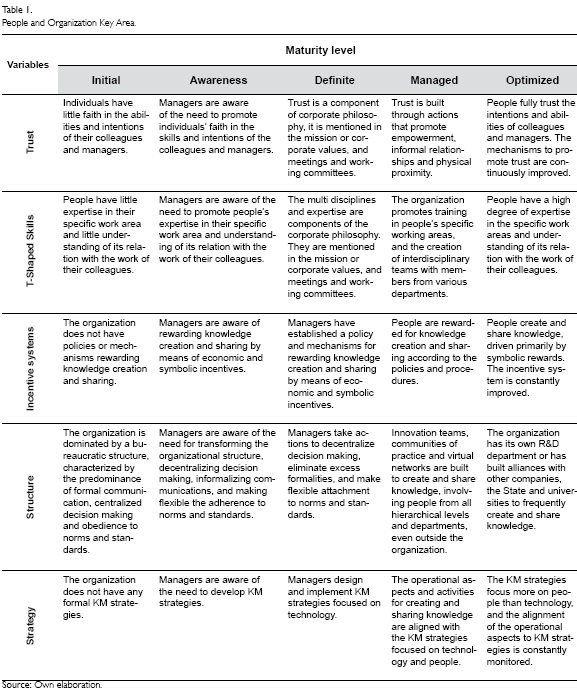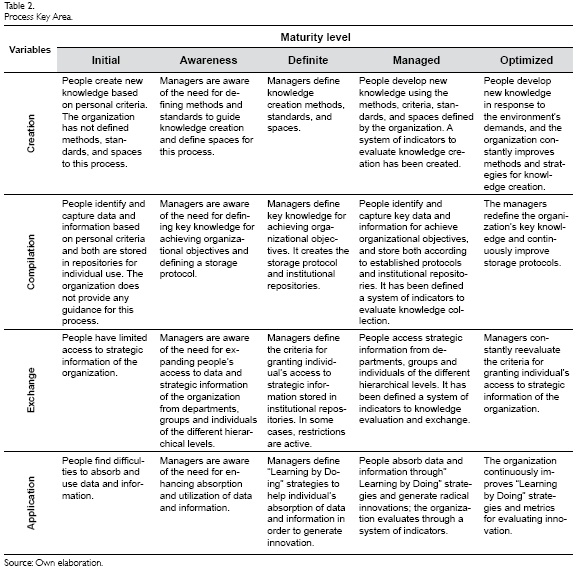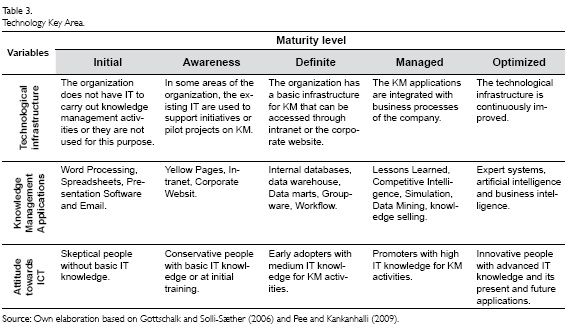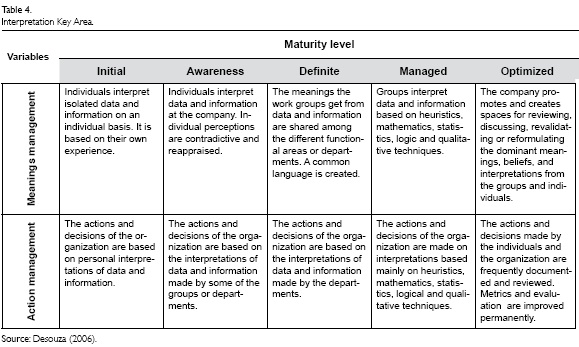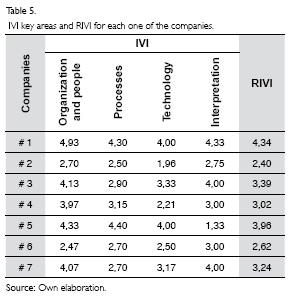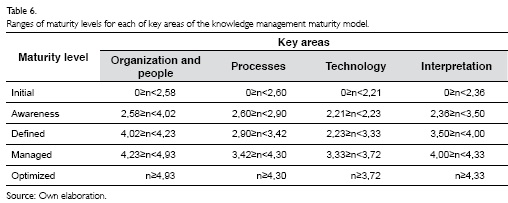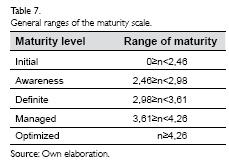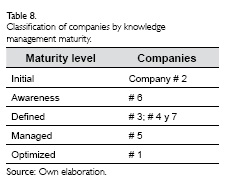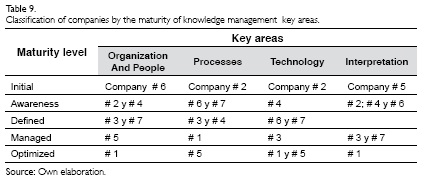Services on Demand
Journal
Article
Indicators
-
 Cited by SciELO
Cited by SciELO -
 Access statistics
Access statistics
Related links
-
 Cited by Google
Cited by Google -
 Similars in
SciELO
Similars in
SciELO -
 Similars in Google
Similars in Google
Share
Entramado
Print version ISSN 1900-3803
Entramado vol.11 no.1 Cali Jan./June 2015
https://doi.org/10.18041/entramado.2015v11n1.21112
http://dx.doi.org/10.18041/entramado.2015v11n1.21112
Exploring knowledge management maturity from funcionalist and interpretivist perspectives*
Aproximación a la madurez de gestión del conocimiento desde las perspectivas funcionalista e interpretativa
Abordagem da maturidade de gestão do conhecimento a partir das perspectivas funcionalista e interpretativa
José Enrique Arias-Pérez**, Carlos Mario Durango-Yepes***
* The article is the result of a research project called: "Knowledge Management Maturity in Big Companies in Medellín, Colombia". It was funded by the Fundación Universitaria Luis Amigo, Medellín, Colombia in 2010.
** Magíster en Gestión de Ciencia y Tecnología, Universidad de Antioquia, Medellín - Colombia. Miembro del grupo GESTOR, Departamento de Ciencias Administrativas, Universidad de Antioquia. Profesor Departamento de Ciencias Administrativas, Universidad de Antioquia, Medellín - Colombia. jenrique.arias@udea.edu.co
*** Magíster en Gestión Tecnológica, Universidad Pontificia Bolivariana, Medellín - Colombia. Miembro del grupo GORAS, Fundación Universitaria Luis Amigó. Docente, Facultad de Ciencias Administrativas, Económicas y Contables, Fundación Universitaria Luis Amigó, Medellín - Colombia. carlosdster@gmail.com
Este es un artículo Open Access bajo la licencia BY-NC-SA (http://creativecommons.org/licenses/by-nc-sa/4.0/)
Cómo citar este artículo: ARIAS-PÉREZ. José Enrique; DURANGO-YEPES, Carlos Mario. Exploring knowledge management maturity from funcionalist and interpretivist perspectives. En: Entramado. Enero - Junio, 2015 vol. 11. no. 1, p. 94-104, http://dx.doi.org/10.18041/entramado.2015v11n1.21112
Recibido: 02/11/2014 Aceptado: 20/12/2014
Abstract
The purpose of this article is to explore the Knowledge Management Maturity Model (KMMM) in big companies that are pioneers in the implementation of KM practices in Medellin, Colombia. The KMMM integrates the Funcionalist and Interpretivist perspectives on knowledge management and consists of four key areas: Organization and People, Processes, Technology, and Interpretation. Cluster analysis helped establishing the ranges of the five maturity levels: Initial, Awareness, Defined, Managed, and Optimized. The results showed that only two companies overcame the "Defined" level, and the best performance was achieved in theTechnology key area. In conclusion, the companies have difficulties at going further the implementation of basic KM i nitiatives and achieving a higher l evel of maturity associated with the articulation of KM practices with business processes and a higher degree of appropriation and usage by individuals. This may occur because of the preponderance of the Functionalist approach in the business context and the low level of penetration and integration with the Interpretivist perspective of KM.
Keywords: Knowledge management, maturity models, innovation management, Knowledge management maturity knowledge management practices.
JEL classification M10, M15.
Resumen
El propósito del artículo es analizar la madurez de gestión del conocimiento (GC) de grandes empresas que han sido pioneras en la implementación de prácticas de GC en Medellín, Colombia. Para ello, se desarrolla un modelo de madurez que integra las perspectivas de GC: funcionalista e interpretativa; además, comprende cuatro áreas claves: Organización y Personas, Procesos, Tecnología, e Interpretación y una escala de madurez. En cuanto a lo metodológico, el análisis Clúster permitió establecer los rangos de los cinco niveles de madurez: Inicial, consciencia, definido, gestionado y optimizado. Los resultados muestran que sólo dos empresas superaron el nivel definido, y los mejores resultados se obtuvieron en el área clave Tecnología. En conclusión, las empresas tienen dificultades para ir más allá de la implementación de las prácticas básicas de GC, y lograr un mayor nivel de madurez asociado a la articulación de las prácticas de GC con los procesos de negocio, y a un mayor uso y apropiación por parte de los individuos. Lo anterior puede derivarse de la preponderancia del enfoque funcionalista de GC y el bajo nivel de penetración e integración con la perspectiva interpretativa.
Palabras clave: Gestión del conocimiento, modelos de madurez, gestión de innovación, madurez de gestión del conocimiento, prácticas de gestión del conocimiento.
Códigos JEL M10, M15
Resumo
O objetivo desse artigo é analisar a maturidade da gestão do conhecimento (GC) de grandes empresas que têm sido pioneiras na implementação das práticas de GC em Medellín, Colômbia. Para isso, é desenvolvido um modelo de maturidade que integra as perspectivas de GC: funcionalista e interpretativa; além disso, abrange ainda quatro áreas-chave: Organização e Pessoas, Processos, Tecnologia e Interpretação e uma escala de maturidade. Quanto ao aspecto metodológico, a análise Clúster permitiu estabelecer as gamas dos cinco níveis de maturidade: Inicial, consciência, definido, gerenciado e otimizado. Os resultados mostram que apenas duas empresas ultrapassaram o nível definido e os melhores resultados foram obtidos na área chave da tecnologia. Em conclusão, as empresas têm dificuldades para irem além da implementação das práticas básicas de GC e atingir um nível mais elevado de maturidade associado com a articulação das práticas de GC com os processos de negócio, e a um maior uso e apropriação por parte dos indivíduos. O anterior pode ser derivado da preponderância do enfoque funcionalista de GC e do baixo nível de penetração e integração com a perspectiva interpretativa.
Palabras-chave: Gestão do conhecimento, modelos de maturidade, gestão de inovação, maturidade da gestão do conhecimento, práticas da gestão do conhecimento.
Classificações JEL M1O, M15
Introduction
Knowledge Management (KM) is imperative for companies interested in facing the changing needs of customers, the pressure from competitors and constant technological changes (Bueno, 1998; Drucker, 1993; Safón y Perfeito, 2000; Scarbrough, 2003, Cavusgil et al, 2003). It is also important to boost the innovation that is the most important source of competitive advantage but that depends on an intangible resource such as knowledge (Nonaka and Takeuchi, 1995).
Because of the need to manage this strategic resource, technological solutions appeared to improve data and information collection processes during the eighties. Later, the first KM model was born in the mid-nineties: the SECI (Nonaka and Takeuchi, 1995) whose focus was the creation of knowledge from the interaction between people and information technology.
Since then, the two great prospects for knowledge management: functionalist and interpretivist have important theoretical and methodological developments (Schultze, 1998; Venters, 2003). The first believes that knowledge exists as a representative object of reality which is waiting to be discovered, captured, and encoded by a human agent. The second perspective says knowledge is a construction of subjective and inter-subjective experiences, therefore, the language, the context of the interaction and the meanings become relevant.
However, many companies implement KM initiatives without understanding their life cycle and without any clarity about their key areas and relations among them. Consequently, companies take "the easy road" which is to replicate successful experiences in other contexts without considering the particularities. This is extremely risky and explains many of the failures in implementing KM practices. (Pee and Kankanhalli, 2009).
The main risk for organizations which have implemented KM initiatives is stagnation due to the absence of guidelines to help organizations to discover the goal to be reached and the areas that should be improved. For that reason, KM improvements could stop and some kind of decline begins leading to the dismantling of KM strategies (Arias and Aristizabal, 2008).
On the other hand, the absence of KM guidelines makes benchmarking more difficult for the organizations at local, national, and international levels. This problem is exacerbated when companies build their own conception of KM based on their strengths and weaknesses or the particular point of view of some consulting groups (Pee and Kankan-halli, 2009).
At the end of the nineties, maturity models appeared as a solution to guide the implementation of KM initiatives (Gallagher and Hazlett, 1999). These were a set of principles or practices that described the development of an entity from a base line to an optimum one (Klimko, 2001). In this research, the entity is Knowledge Management that is understood as a process to identify and capitalize collective knowledge of an organization, increasing its competitiveness (Alavi and Leidner, 2001).
The objective of this article is to establish the degree of knowledge management maturity of seven large companies that are pioneers in the implementation of KM in Medellin, the most industrial city in Colombia. These companies have implemented KM initiatives at least for five years and are recognized for their leadership in innovation based on the exploitation of knowledge. The paper also presents a comparative exercise among those companies and structures a guide to establish a standard in the academic and business context.
This article approaches KM from the Funcionalist and Interpretivist perspectives and uses Pee and Kankanhalli's work (2009). These authors have synthesized the main Funcionalist maturity models of KM in a five maturity levels and three key areas: Organization and People, Processes and Technology. However, they do not describe the variables that are part of the key areas because this matter has been poorly researched. On the other hand, this work integrates Interpretivist perspective of KM developed by Desousa (2006) widely in their maturity model that deals with aspects related to meaning management and KM actions of individuals and groups.
1. Knowledge management maturity model based on funcionalist perspective
Nine Funcionalist models of maturity for KM have appeared in the last decade (Klimko, 2001; Weerdmeester et al, 2003; Gottschalk and Khandelwal, 2004; Kulkarni and Freeze, 2004; Mohanty and Chand, 2004; Wong and Aspinwall, 2004; Pee and Kankanhalli, 2009), and most of them take as a reference the five levels provided by the CMM: Initial, Awareness, Defined, Managed, and Optimized. All of them share the idea of three key areas: People and Organization, Processes and Technology. However, there are differences in the scales of maturity.
Some authors have made an effort to integrate these nine proposals into a General KM Maturity Model (Pee, Teah and Kankanhalli, 2006; Pee and Kankanhalli, 2009), taking up the CMM scale and the three key areas both mentioned before. However, the main models of knowledge management maturity have been developed by consulting firms therefore have many theoretical gaps that hinder the development of academic research.
1.1. Knowledge management maturity levels
According to Pee and Kankanhalli (2009) in the Initial level of KM maturity, organizations have little or no intention at all of using organizational knowledge. In the Awareness level, organizations intend to manage their organizational knowledge but may not know how to do it. In the Defined I level they design and implement an infrastructure that supports KM. In the Managed level, KM initiatives are working and coordinated by some areas of the organization. In the Optimized level, KM is fully integrated into business processes and is continuously improved. As it was mentioned before, despite of the fact that there is a consensus in literature regarding the establishment of five maturity levels and three key areas (Pee and Kankanhalli, 2009; Desouza, 2006), the KM maturity models do not indicate the variables that are part of each key area.
1.2. Key area: people and organization
This area is the most difficult to comprehend because it is usually conceived as a set of variables on which there is no consensus and this prevents identifying its scope and limits. So, in order to clarify this issue it is necessary to determine the organization's concept behind maturity models (Lee and Choi, 2003).
The organization's concept behind the Organization Maturity Model is consistent with Katz and Kahn (1977) and Kast and Rosenzweig (1988). It is conceived by the first two as a system composed of a technical subsystem which refers to the Processes and Technology, and a social subsystem that is composed of attributes and relations of people, incentive systems and organizational structure.
Based on Katz and Kahn's approach (1977), the technical subsystem includes two key areas of the maturity model: Process and Technology. The social subsystem corresponds to the People and Organization key area. However, according to Kast and Rosenzweig (1988), a technical and social subsystem must be complemented by an administrative subsystem that coordinates and controls the flow of knowledge in business processes to create core competencies (Davenport and Prusak, 1998).
Along these lines, the People and Organization key area is deals with the integration of variables related to social and administrative subsystems (Hsieh et al, 2009). Therefore, this key area includes variables such as relations and attributes of people, system incentives, organizational structure, and planning, coordinating and controlling the flow of knowledge.
Relations and attributes of individuals correspond respectively to culture and T-shaped skills (Lee and Choi, 2003; Detienne et al, 2004), planning with strategy (Ewing and West, 2000), coordination with leadership (Politis, 2001) and controlling the flow of knowledge with evaluation (Tiwana, 2002). In the case of the incentive systems and the organizational structure, there are many direct references to the roles they play as enablers (Lee and Choi, 2003, Gold et al, 2001, Chen and Huang, 2007; Detienne et al , 2004).
Additionally, some authors have divided variables such as culture to facilitate understanding which consists of collaboration, trust and learning (Lee and Choi, 2003; Detienne et al, 2004). Subsequently, some redundancies were identified and some variables were eliminated. The Organization and People key area include the following variables: Trust, T-shaped Skills, Incentive Systems, Structure, and Strategy (see Table 1).
Similarly, generic KM processes were identified and conceptualized by comparing the proposals of the most representative authors such as Ruggles (1997, 1998), Alavi and Leidner (2001), Holsapple and Joshi (2002), Sabherwal and Sabherwal (2005), Lee and Lee (2007) and Zhao (2010).
These processes are:
- Creation: developing new knowledge and procedures based on patterns, meanings and relations among data, information and prior knowledge.
- Collection: identifying, capturing and storing data, information or knowledge in a way that can later be retrieved.
- Exchange: granting access to people who should know certain information or blocking it if necessary.
- Application: absorbing and utilizing data, information, and knowledge to perform tasks and generate innovation.
Table 2 shows the Process key area which includes the following variables: Creation, Collection, Exchange and Application.
Gottschalk and Solli-Sther (2006) groups KM technologies into four stages according to their degree of complexity and usefulness, they are: Stage I is called "end-user-tool systems". In this stage, technology improves the efficiency of the people at their workplace, for instance, word processor, spreadsheets, presentation software, and e-mails. Stage II is called "person to person" because technology is used to find other knowledge workers. It is about who knows what it is inside and outside the company. Some examples are the yellow pages, intranets, corporate portals, among others.
Stage III is called "information to the person". It is focused on providing information in large repositories and enabling interaction among people. It includes technologies such as datawarehouse, datamarts, groupware, workflow, among others. Stage IV is called "system to person". In this stage, the system helps people solve a problem of knowledge, for instance, system experts, artificial intelligence, and business intelligence.
In addition, it is necessary to consider the integration of technology infrastructure and business processes (Pee and Kankanhalli, 2009), and attitudes of individuals regarding ICT, which are categorized in the following way: skeptical, conservative, early adopters, developers, and innovators (Peinado et al, 2011).
The Table 3 shows the Technology key area, which includes the following variables: Technological Infrastructure Integration, KM Applications, and Attitude towards ICT.
1.5. Knowledge management maturity model based on interpretivist perspective
Some critics believe that Funcionalist models have an incomplete view of KM which is poorly based on knowledge theories (Desouza, 2006; Serna, 2012). Therefore, studies that seek for setting up a maturity model based on an Interpretivist perspective of KM have emerged. It is rooted in semiotics and theories of learning.
From this perspective, KM consists of four components: Resource Management, Analytical Management, Meaning Management, and Action Management (Ramaprasad and Ambrose, 1999; Desouza, 2006). This classification is based on Semiotics, the general science of signs which consists of four large fields: Morphology which studies the source of the signs. Syntax which focuses on relations between signs. Semantics which focuses on the meanings and Pragmatics which analyzes the meanings in connection with the actions of individuals (De Saussure, 2011).
Resource Management based on morphology refers to the identification of sources of information and knowledge. Analytical Management based on syntax refers to the processing and use of information. Meaning Management based on semantics refers to the ability to make sense of information and form an opinion about the environment. Action Management related to pragmatics speaks of the ability to act upon the meanings previously developed and evaluate the feedback for future actions. The Table 4 shows the Interpretation Key Area. Source Management and Analytical Management were excluded for being redundant with variables of Funcionalist key areas such as Process and Organization and People.
2. Material and methods
KM maturity was measured in a total of seven big companies that have implemented KM initiatives at least for five years in Medellin, Colombia. It is a reasonable time for developing KM implemented practices (Desouza, 2006). These companies are also recognized for their leading innovation based on the exploitation of knowledge at their economic sectors. They belong to certain economic groups focused on specific economic sectors.
In detail, this exploratory research was conducted in a financial company whose income exceeded US$ 6,000 million in 2011. Two other companies belong to the energy sector. one of them had sales over US$2,500 million and the other one near US$800 million. Another company at the cement industry had sales over US$2,000 million. Another one had sales near US$1,000 million at the Telecommunications sector. Another one had sales of US$140 million at the Ceramic and sanitary ware sector and one belonging to the sweets industry with sales over US$1,700 million. In Medellin, the most industrialized city in Colombia, these selected big companies are the pioneers in the implementation of KM practices.
For collecting empirical information, a questionnaire composed of 14 items was designed. The number of items corresponds to the number of variables of the four key areas with a scale of 5 answer choices that was adjusted to the 5 maturity levels. The questionnaire was sent to 7 companies, particularly to people who coordinate KM activities or belong to departments where KM methodologies are extensively used. They have a broad view of maturity model key areas.
Concerning data processing, a database was built, it assigned value to five response options, 1 for the initial level of maturity scale, 2 for the Awareness level, 3 for the Defined level, 4 for the Managed level and 5 to the Optimized level. In addition, the variables were relativized or semi-quantified to use multivariate analysis, assigning a weight to each one in a panel of experts. This is multiplied by its score and divided by the sum of the weights of all the variables belonging to one of four key areas (Lema, 2002). With the semi-quantitative variables, a Relativized Importance Value Index (RIVI) was built for each of the companies, which is a dimensional indicator that shows the degree of statistical significance that any group or individual has in a context (see Table 5), according to all of the characteristics of the variables (Lema, 2002). Before calculating the RIVI, it is necessary to add the variable values belonging to each of the key areas to each of the companies, and this way, the Importance Value Index (IVI) is built.
Then a panel of experts assigned a weight to each key area which was multiplied by the corresponding IVI. The results were added and divided by the sum of the weights. 4 were assigned to processes, 3 to Technology, 2 to Organization and people and 1 to Interpretation. The panel was integrated by 13 people among researchers, consultants and professionals; 7 of them were the KM coordinators at the correspondent companies, 4 of them were researchers and 2 of them were renowned researchers. The key areas' weights were established by applying the Delphi method.
In order to establish the ranges of the maturity scale levels, Hsieh et al. (2009) methodology was applied which had been partially or completely replicated by several researchers (Strasunskas & Tomasgard, 2009; Kale and Karaman, 2011; Xu and Bernard, 2010; Lee et al., 2010; Cheng and Fong, 2012; Lin et a.l, 2012; Lu et al., 2012). This methodology is based on the cluster analysis aimed at classifying the observations according to the homogeneity degree particularly. The K-means non- hierarchical technique was used. It is usually used when the number of groups or conglomerates is known beforehand. The K-means technique is applied independently to each of the key areas and their respective variables, assuming that companies do not have a uniform level of maturity, for instance some firms may have strengths in Organization and People but others may have weaknesses in Technology.
In this case, the observations were classified into four clusters although the scale has five levels of maturity. It was assumed that the majority of the companies are over the Initial level because the study was conducted with those having implemented KM initiatives for at least five years. Then, the values resulting from the cluster analysis of the variables of each key area were added up in each of the four clusters. These data were used to create the 5 ranges corresponding to the five levels of maturity, identifying their upper and lower levels (see Table 6). At this point, it is possible to determine the maturity of companies by finding the IVI of their key areas in the ranges (Hsieh et al., 2009).
In the same way, the general ranges in the KM maturity scale are calculated by using the same logic of the IVIR and by multiplying the sum of the clusters values located in the Awareness, Defined, Managed and Optimized maturity levels by the weight of the dimension they belong to. Then, this is then divided by the sum of the weights (See Table 7). Finally, the RIVI of each of the companies (see Table 5) can be located in one of the general ranks (see Table 7) to identify the general level of KM maturity of the companies, not for key areas.
3. Results
As for the general maturity of the companies, it was found that only one of them is on the Optimized level, one in the Managed level, three in the Defined level and the other two in the Awareness level and Initial level respectively (see Table 8). It is noted that five of the seven organizations have not exceeded the defined level, the implementation stage of basic or primary initiatives which is surprising because all companies have spent several years working on the consolidation of KM.
Analyzing the data by key areas (see Table 9), there is some consistency with what is presented in the table above. In People and Organization and Processes, only two companies overcome the Defined level, but the best results are appreciated in Interpretation and Technology, because in both cases the number of companies amounts to three.
However, it is clear that there has been a greater concern for the key area of technology, because it is the only one in which two companies have reached Optimized level. This indicates the implementation of expert systems, artificial intelligence, and possession of advanced knowledge in the use of information technology.
On the other hand, there are differences in the maturity of key areas, company # 5 which is at the Managed level in the general scale (see Table 9). It leads Processes and Technology but is behind in interpretation and organization and people where it is located at the initial level, indicating that KM is understood primarily from a Funcionalist perspective and Interpretivist approach has been ignored. This contrasts with what happens in company # 7 that is located at the Defined level of technology but in interpretation is located at the Managed level that means more emphasis on the soft aspects of KM. A third group of companies has a certain homogeneity in the maturity of key areas, such as # 1 and # 3, in which technology and interpretation respectively are at the same level Optimized and Managed. This indicates that KM is seen from both perspectives: the Funcionalist and the Interpretivist.
Conclusions
The companies have better results in the key area of technology which indicates the predominance of functionalism perspective. However, there are notorious efforts in a few companies to intervene soft KM aspects relating to the Interpretivist approach. The most important finding is that most of the companies are failing to overcome the Defined level that is the stage where the basic practices are implemented. They have some difficulties to achieve a higher level of maturity associated with the articulation of KM practices with business processes and a higher degree of appropriation and use by individuals.
Regarding the academic contributions, the paper presents an integration of the two main perspectives of knowledge management maturity. Also, this work represents progress in identifying the variables to be monitored and further developed in each one of the key areas. This is highly relevant because the main models of knowledge management maturity often generically address key areas so without opening the black box which makes it difficult to further investigate this matter.
With respect to contributions to the practice of knowledge management in business, the KMMM developed in this article is a roadmap for companies which allow considering all aspects related to the creation and use of knowledge. However, this assumes greater challenges in the articulation of the different functional areas involved in the deployment of the various components of the maturity model. Particularly, the model emphasizes the need to implement practices that support employees in the interpretation of data and information.
So, there are several future research directions. The first has to do with the need to analyze the organizational factors that act as inhibitors of the maturity of knowledge management and do not leave companies go beyond the defined level of maturity. The second is related to the improvement scenarios maturity of each variable with the aim of making measurements have greater validity and reliability. It is also necessary to advance in the reduction of maturity levels to get a better differentiation of the five levels among them. This could simplify the collection of empirical information and data processing.
Another future research direction involves analyzing the impact of maturity on financial performance and innovative performance, which is a subject little explored in the literature and could have many implications for knowledge management in companies. Particularly, it would be important to identify key areas and variables that most influence these results. This would concentrate all resources and organizational efforts on these variables reach their full maturity level.
Conflict of interest
The authors declare no conflict of interest.
References
1. ALAVI, Maryam; LEIDNER, Dorothy E. Review: Knowledge management and knowledge management systems: Conceptual foundations and research issues. En: MIS quarterly, 2001, p. 107-136. [ Links ]
2. ARIAS PÉREZ, José Enrique; ARISTIZÁBAL BOTERO, Carlos Andrés. Influencia de la estructura organizacional en la creación de conocimiento, estudio del caso EPM Medellín. En: Semestre Económico, 2011, vol. 11, no 22, p. 161-184. [ Links ]
3. BLOOM, B. S., et al. Taxonomy of educational objectives: The classification of education goals. Handbook I: Cognitive domain (Vol. 1). New York, NY: David McKay Company. 1956. [ Links ]
4. BUENO CAMPOS, Eduardo. El capital intangible como clave estratégica en la competencia actual. En: Boletín de estudios económicos, 1998, vol. 53, no 164, p. 207-229. [ Links ]
5. CAVUSGIL, S. Tamer; CALANTONE, Roger J.; ZHAO, Yushan. Tacit knowledge transfer and firm innovation capability. En: Journal of business & industrial marketing, 2003, vol. 18, no 1, p. 6-21. [ Links ]
6. CHEN, Chung-Jen; HUANG, Jing-Wen. How organizational climate and structure affect knowledge management-The social interaction perspective. En: International Journal of Information Management, 2007, vol. 27, no 2, p. 104-118. [ Links ]
7. CHEN, Le; FONG, Patrick SW. Revealing performance heterogeneity through knowledge management maturity evaluation: A capability-based approach. En: Expert Systems with Applications, 2012, vol. 39, no 18, p. 13523-13539. [ Links ]
8. DAVENPORT, Thomas; PRUSAK, Laurence. Working Knowledge: How organizations manage what they know. Boston: Harvard Business School Press, 1998. [ Links ]
9. DESOUZA, Kevin. Knowledge Management Maturity Model: Theoretical development and preliminary empirical testing. Chicago: University of Illinois, 2006, 386 p. [ Links ]
10. DETIENNE, Kristen Bell, et al. Toward a model of effective knowledge management and directions for future research: culture, leadership, and CKOs. En: Journal of Leadership & Organizational Studies, 2004, vol. 10, no 4, p. 26-43. [ Links ]
11. DRUCKER, Peter. Post-capitalist Society. (1st Ed.). New York: Harper Collins, 1993. [ Links ]
12. EWING, Michael; WEST, Dick. Advertising knowledge management: strategies and implications. En: International Journal of Advertising, vol. 19, no 2, p. 225-243. [ Links ]
13. GALLAGHER, Simon; HAZLETT, Scott. Using the Knowledge Management Maturity Model (KM3) as an Evaluation Tool. Paper presented at the Conference on. Conference on Knowledge Management Concepts and Controversies, University of Warwick, Conventry, United Kingdom, 1999. [ Links ]
14. GOLD, Andrew H.; MALHOTRA, Arvind; SEGARS, Albert H. Knowledge management: an organizational capabilities perspective. En: J. of Management Information Systems, 2001, vol. 18, no 1, p. 185-214. [ Links ]
15. GOTTSCHALK, Petter; SOLLI-S/ETHER, Hans. Maturity model for IT outsourcing relationships. En: Industrial Management & Data Systems, 2006, vol. 106, no 2, p. 200-212. [ Links ]
16. GOTTSCHALK, Petter; KHANDELWAL, Vince. Stages of growth for Knowledge Management Technology in Law Firms. En: The Journal of Computer Information Systems, 2004, vol. 44, no 4, p. 111-124. [ Links ]
17. HOLSAPPLE, Clyde W.; JOSHI, Kshiti D. Knowledge management: a threefold framework. En: The Information Society, 2002, vol. 18, no 1, p. 47-64. [ Links ]
18. HSIEH, Ping Hsieh; LIN, Binshan; LIN, Chinho. The construction and application of knowledge navigator model (KNM): An evaluation of knowledge management maturity. En: Expert Systems with Applications, 2009, vol. 36, no 2, p. 4087-4100. [ Links ]
19. KALE, Serdar; KARAMAN, Erkan A. Evaluating the knowledge management practices of construction firms by using importance-comparative performance analysis maps. En: Journal of Construction Engineering and Management, 2011, vol. 137, no 12, p. 1142-1152. [ Links ]
20. KAST, Freemont; ROSENZWEIG, James. Administración en las organizaciones: Enfoque de sistemas y contingencias. México: McGraw Hill, 1988. [ Links ]
21. KATZ, Daniel, et al. Psicología social de las organizaciones. México: Editorial Trillas, 1977. [ Links ]
22. KLIMKO, Geral. Knowledge Management and Maturity Models: Building Common understanding. Paper presented at Proceedings of the 2nd European Conference on Knowledge Management, Bled, Slovenia, 2001. [ Links ]
23. KULKARNI, Uday R.; RAVINDRAN, Sury; FREEZE, Ronald. Development and validation of a knowledge management capability assessment model. Paper presented at Proceedings of the Twenty-Fifth International Conference on Information Systems, Washington, D.C. USA, 2004. [ Links ]
24. LEE, Heeseok; CHOI, Byounggu. Knowledge management enablers, processes, and organizational performance: an integrative view and empirical examination. En: Journal of management information systems, 2003, vol. 20, no 1, p. 179-228. [ Links ]
25. LEE, Young-Chan; LEE, Sun-Kyu. Capabilities, processes, and performance of knowledge management: a structural approach. Human Factors and Ergonomics in Manufacturing & Service Industries, 2007, vol. 17, no 1, p. 21-41. [ Links ]
26. LEE, Jeehae; SUH, Eui-ho; HONG, Jongyi. A maturity model based CoP evaluation framework: A case study of strategic CoPs in a Korean company. En: Expert Systems with Applications, 2010, vol. 37, no 3, p. 2670-2681. [ Links ]
27. LEMA, Álvaro. Elementos de Estadística Multivariada. Medellín: Silvano Ltda, 2002. [ Links ]
28. LIN, Chinho; WU, Ju-Chuan; YEN, David C. Exploring barriers to knowledge flow at different knowledge management maturity stages. En: Information & Management, 2012, vol. 49, no 1, p. 10-23. [ Links ]
29. LU, Yang; MENGJUN, Wang; ZHANG, Zhensen. Maturity Evaluation for Highway Site Standardization Management Based on AHP-FUZZY. En: Advances in Information Sciences & Service Sciences, 2012, vol. 4, no 22. [ Links ]
30. MOHANTY, Santosh; CHAND, Manish. 5iKM3 knowledge management maturity model. TCS, 2005. [ Links ]
31. NONAKA, Ikujirõ; TAKEUCHI, Hirotaka. The knowledge-creating company: How Japanese companies create the dynamics of innovation. Oxford university press, 1995. [ Links ]
32. PEE, Loo Geok; KANKANHALLI, Atreyi. A model of organisational knowledge management maturity based on people, process, and technology. En: Journal of Information & Knowledge Management, 2009, vol. 8, no 02, p. 79-99. [ Links ]
33. PEE, Loo Geok; TEAH, Huan Ying; KANKANHALLI, Atreyi. Development of a General Knowledge Management Maturity Model. Paper presented at Korean Knowledge Management Society Conference, Seoul, Korea, 2006. [ Links ]
34. PEINADO, Sofía, et al. Actitud hacia el uso de la computadora en docentes de educación secundaria. En: Revista universitaria arbitrada de investigación y diálogo académico, 2011, vol. 7, no 1, p. 86-105. [ Links ]
35. POLITIS, John D. The relationship of various leadership styles to knowledge management. En: Leadership & Organization Development Journal, 2001, vol. 22, no 8, p. 354-364. [ Links ]
36. RAMAPRASAD, Arkalgud; AMBROSE, Paul. The semiotics of knowledge management. Paper presented at Workshop on Information Technology & Systems, Charlotte, USA, 1999. [ Links ]
37. RUGGLES, Rudy. Knowledge management tools. Oxford: Butterwor-th-Heinemann, 1997. [ Links ]
38. RUGGLES, Rudy. The state of the notion: Knowledge Management in Practice. En: California Management Review, 1998, vol 40, no 3, p. 80-89. [ Links ]
39. SABHERWAL, Rajiv; SABHERWAL, Sanjiv. Knowledge Management Using Information Technology: Determinants of Short-Term Impact on Firm Yalue. En: Decision Sciences, 2005, vol. 36, no 4, p. 531-567. [ Links ]
40. SAFÓN, Vicente; PERFEITO, Juarez. La flexibilidad en la pequeña empresa: un estudio respecto al desarrollo de un concepto operativo y cuantitativo. Revista de Negócios, 2006, vol. 11, no 4, p. 39-81. [ Links ]
41. DE SAUSSURE, Ferdinand. Course in general linguistics. Columbia University Press, 2011. [ Links ]
42. SCARBROUGH, Harry. Knowledge management, HRM and the innovation process. En: International Journal of Manpower, 2003, vol. 24, no 5, p. 501-516. [ Links ]
43. SCHULTZE, Ulrike. Investigating the Contradictions in Knowledge Management. Paper presented at IFIP WG8.2 & WG8.6 Joint Working Conference on Information Systems: Current Issues and Future Changes, Helsinki, Finland, 1998. [ Links ]
44. SERNA, Edgar. Maturity model of Knowledge Management in the interpretativist perspective. En: International Journal of Information Management, 2012, vol. 32, no 4, p. 365-371. [ Links ]
45. STRASUNSKAS, Darijus; TOMASGARD, Asgeir. In quest of ICT value through integrated operations: assessment of organisational-technological capabilities. En Business Information Systems Workshops. Springer Berlin Heidelberg, 2009. p. 159-170. [ Links ]
46. TIWANA, Amrit. The Knowledge Management Toolkit: Orchestrating IT, Strategy and Knowledge Platform. Upper Saddle River: Prentice Hall, 2002. [ Links ]
47. VENTERS, William James. The introduction of knowledge management technology within the British Council: an action research study. 2003. Tesis Doctoral. University of Salford. [ Links ]
48. WEERDMEESTER, Ron; POCATERRA, Chiara; HEFKE, Mark. VISION: Next Generation Knowledge Management: Knowledge Management Maturity Model. Information Societies Technology Programme, 2003. [ Links ]
49. WONG, Kuan Yew; ASPINWALL, Elaine. Development of a knowledge management initiative and system: A case study. En: Expert Systems with Applications, 2006, vol. 30, no 4, p. 633-641. [ Links ]
50. XU, Yang; BERNARD, Alain. Quantifying the value of knowledge within the context of product development. En: Knowledge-Based Systems, 2011, vol. 24, no 1, p. 166-175. [ Links ]
51. ZHAO, Jingyuan. School knowledge management framework and strategies: The new perspective on teacher professional development. En: Computers in human behavior, 2010, vol. 26, no 2, p. 168-175. [ Links ]













